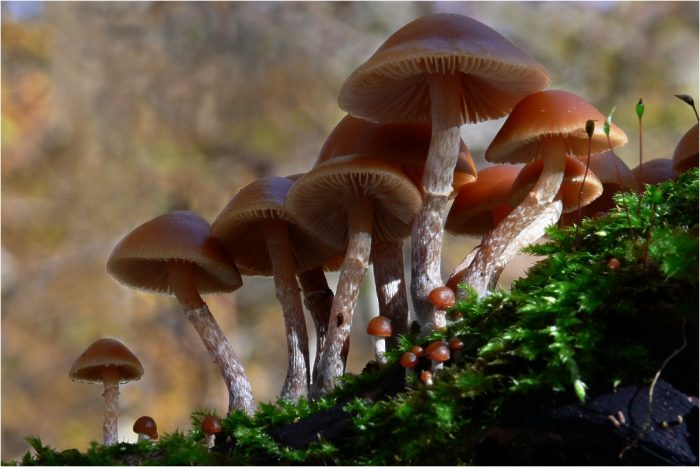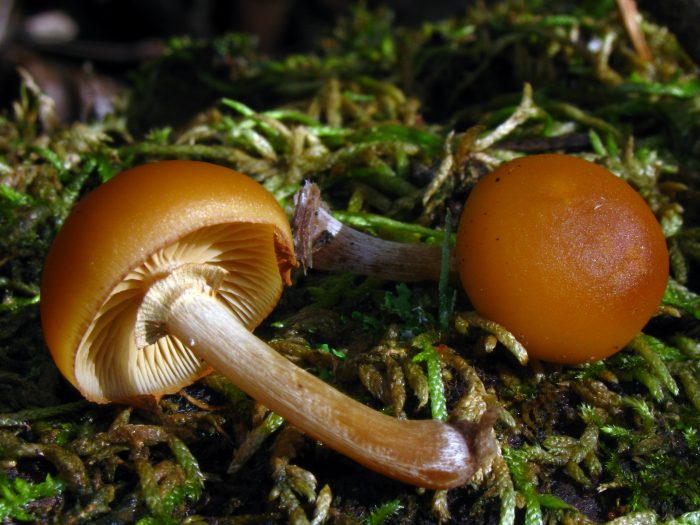Poisonous mushrooms – Funeral bells
Galerina marginata, Galerina autumnalis
AKA Deadly galerina
I was quite shocked to see this mushroom ignored in a chapter on the edible sheathed woodtuft (Kuehneromyces mutabilis) in Alistair Schwab’s otherwise excellent beginners mushroom identification book “Mushrooming with confidence” (click link for a review). He advocates a ‘positive approach to identification’, designed to avoid filling the novice picker with confusion and dread, which I thoroughly approve of. The sheathed woodtuft and funeral bell however, are so similar that I think it is quite irresponsible – to the point of actively dangerous – not to mention them together.
The funeral bell contains the same toxins as the death cap, and will kill you with similar sadistic efficiency if you give it the chance. Both funeral bell and sheathed woodtuft grow in troops on dead wood (though this may be hidden in soil) and often have hygrophanous (ie. zonated colour distinction caused by differentiated moisture content) orange-brown caps. Both have brownish coloured spores. The only real consistent, non-microscopic difference is the
silvery-pale, ringed stipe with longitudinal fibres of the funeral bell
compared to the
cream-topped, skin-like ring, scaly based stipe of the sheathed woodtuft.
Clear on that? Would you stake your life on knowing the difference?
Sheathed woodtuft are tasty mushrooms, but unless you are very, or rather 100%, confident I doubt you will enjoy eating them. There are plenty of safer, tastier mushrooms out there, so is it really worth it?
All this is not to say that you shouldn’t try to get to grips with the differences – that is the best way to advance your ID skills for all fungi. There is never any obligation to eat!
Two other common, tasty edible fungi, honey fungus (armillaria spp) and velvet shank (flamunilla velutipes), also look similar to the funeral bell.
They are more straightforward to positively identify (both have pale spores for example, and velvet shank is a winter mushroom, so seasons are unlikely to overlap), but you should always be extra careful if you are picking any brown fungi growing in groups from wood. Double check that your honey fungus has white spores and honey coloured caps with fine dark scales concentrated in the centre.
Related pages:




8 Comments
Hi there
Can you inform me where you found these funeral bells?
I never realised you got them in the south west, I was of the opinion they are a rarity.
Kind regards
Stephen Pagan, Dumfries
Hi Stephen,
I found these particular ones at Kirkconnel flow, on dead deciduous trees near the car park. I have also found them near Glen Trool. A really good one to find and get familiar with! I don’t find them often, but they are described as “widespread and common” in my books. Oddly, Roger Phillips omits them completely from his (updated) Mushrooms book. I have no idea why.
Happy hunting,
Mark
what is the best way to distinguish the funeral bell mushrooms from the edible sheathed woodtuft?
Errr…did you read this page before you commented? I don’t think it could be much clearer on this point. I know professional mycologists who don’t eat sheathed woodtuft due to the similarities to funeral bell, so certainly not recommended for anyone who can’t read a web page! 😉
What is a stipe?
Another word for the stem of a mushroom.
Have just finished “Mushrooming with Confidence” and was impressed with its approach especially for novices like myself. Therefore thanks immensely for your warning/advice on the similarity between Sheathed Wood tuft and Funeral Bells. Certainly an omission by the author which could prove fatal to the inexperienced forager. Thanks again Mark
There is no point in playing Russian Roullete with eating fungi.There are plenty of tasty easily recognised fungi for the pot.